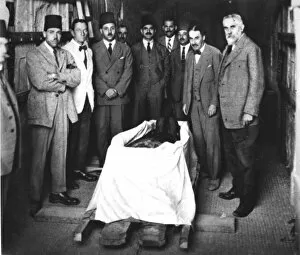Tutankhamuns Collection
"Unveiling the Secrets of Tutankhamun's Tomb: A Journey with Howard Carter and Lord Carnarvon" In 1922, renowned archaeologist Howard Carter
All Professionally Made to Order for Quick Shipping
"Unveiling the Secrets of Tutankhamun's Tomb: A Journey with Howard Carter and Lord Carnarvon" In 1922, renowned archaeologist Howard Carter, accompanied by his patron Lord Carnarvon, made history as they discovered the long-lost entrance to Tutankhamun's tomb in Egypt. This remarkable find would forever change our understanding of ancient Egyptian civilization. Among those present during this monumental moment was Lady Evelyn Herbert, daughter of Lord Carnarvon. Together with Carter and Callender, they embarked on a daring adventure into the depths of Tutankhamun's burial chamber. As they entered the tomb for the first time, their eyes beheld an awe-inspiring sight. Amongst the treasures that lay before them was Tutankhamun's ivory fan adorned with delicate ostrich feathers – a testament to the opulence and grandeur that surrounded this young pharaoh in life and death. Men from all walks of life joined forces to assist Howard Carter in meticulously documenting and preserving each artifact found within Tutankhamun's tomb. Their dedication ensured that these priceless relics would be safeguarded for generations to come. One such treasure was a carved ivory headrest – an exquisite piece symbolizing comfort in eternity. It stood as a reminder of how even in death, Pharaohs sought solace amidst lavish surroundings. Another remarkable find was none other than Tutankhamun's throne itself - dating back to approximately 1340 BC. Its intricate design spoke volumes about ancient Egyptian craftsmanship while offering insights into royal power dynamics during that era. Venturing further into Egypt's rich history, we catch glimpses inside Seti I’s tomb - its interior showcasing breathtaking artistry etched onto every surface. These discoveries shed light on not only King Seti I but also on his successors who followed him down this sacred path. Step by step, through rock-cut passages carefully excavated by Howard Carter and Mr.













